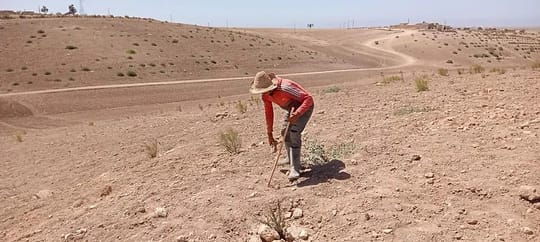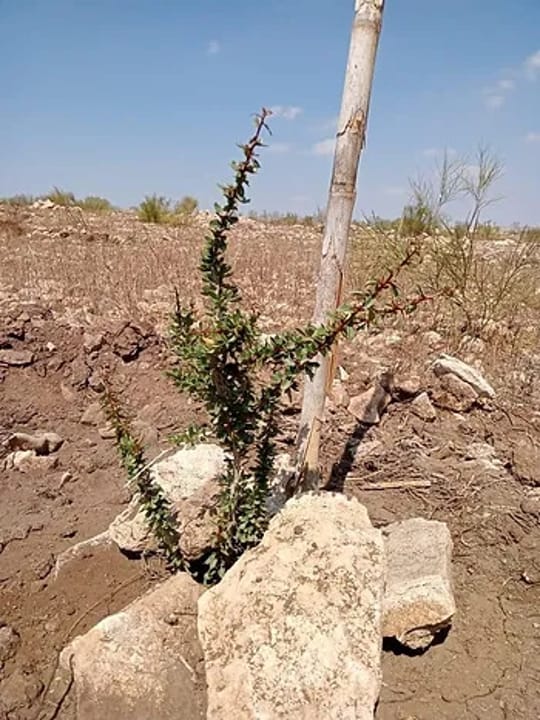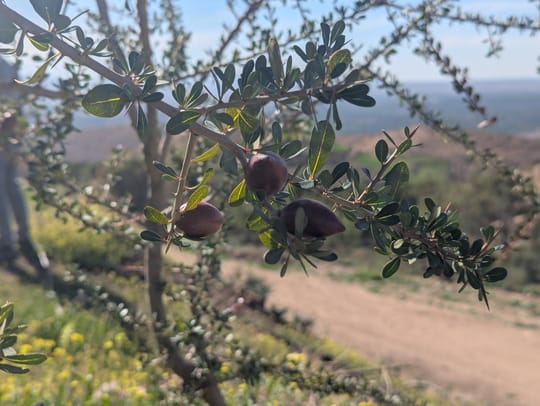On a visit to the city of Safi, a charming city with a deep history and cultural heritage, we focused on monitoring the growth and health of fruit trees that we previously distributed to farmers in the region. What caught our attention in this city was the abundant presence of argan trees. They attract attention because of their small and beautiful yellow and brown fruits and their captivating natural appearance.
The exciting thing is that we are actively working to contribute to the preservation of this unique natural heritage. As part of our afforestation project in partnership with FRÉ Skincare, we aimed to plant 20,180 fruit trees, distribute them among 13,440 farmers, as well as 6,400 argan and 300 carob trees to over 30 farmers in each of the “Azib Al-Nasrania” roundabout, and “Oulad Bhrir Basfi.
As we explored these trees, a sense of inspiration and hope was sparked in us, both for the existing mature trees that grace the area with beauty and elegance and also for the small, newly planted seedlings that await rain and care from the local population to thrive and enhance the beauty of the place. The argan trees in the region offered a unique sensory and emotional experience that fostered a deep connection with the environment, underscoring the importance of preserving this unique natural heritage. This encounter added a meaningful layer to our human and cultural experiences.

In addition to monitoring the trees, the second goal of our visit was to gain feedback from local community members about the argan tree planting initiative and identify their needs to support them in continuing to grow and benefit from the trees. Through collecting farmers’ input, we learned that for the majority, “planting argan trees will increase their income and will enable them to achieve greater economic stability.” Another farmer expressed that “we realize the importance of preserving the argan tree to prevent desertification and preserve the environment surrounding them.”
They also firmly believe that they “must take care of the argan tree and make sure that they use its resources carefully to ensure its sustainability for future generations, despite the hard work and patience that this type of tree requires. They may face problems like a shortage of resources and funding, but the argan tree is part of their heritage and culture, and they are proud to take care of it and use its products in their daily lives.” Farmers in Douar Azib Al-Nasraniya and Douar Oulad Bharir have also expressed their need for further education to learn how to grow argan trees and increase their production.
There continue to be large, empty regional lands that local community members can plant. The argan tree is considered suitable for the region given its dry and warm climate, sufficient provision of sunlight, and well-drained soil, making it the ideal tree for planting. The trees will also offer many significant benefits to local community members.
First, the argan plants will significantly enhance environmental sustainability by helping to prevent desertification and land degradation and improve air and soil quality. The plants will also provide economic opportunities for the region’s local population as they cultivate the plant, extract argan oil, and manufacture and sell its products. Lastly, argan trees contribute significantly to the preservation of biodiversity in Morocco; if they are carefully planted and cared for, they can act as a haven for wildlife and contribute to the preservation of the region’s ecosystem.
Argan tree cultivation enables farmers to rely on a renewable and sustainable source of income. This cultivation reduces pressure on other natural resources that may be subject to depletion.
Planting the argan tree contributes to the sustainable development of local communities and can contribute to achieving sustainable development goals, such as eliminating poverty and improving local community members’ quality of life. Overall, planting argan trees represents a substantial environmental and economic investment that can bring many ecological benefits to local communities in the areas where this valuable tree grows.

